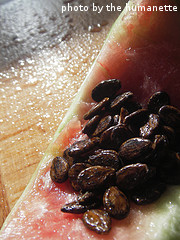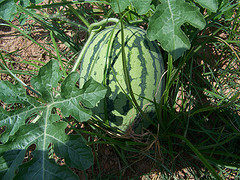Saving Watermelon Seeds
Before saving watermelon seeds, you'll first need to make sure you are dealing with an open-pollinated or non-hybrid variety, otherwise known as an heirloom. If you save seeds from a hybrid variety and replant them, you likely won't get any fruit. Most of the time, the result is a lush plant that doesn't produce. If it does produce a melon, you probably won't be happy with the size or quality. Georgia Rattlesnake and Congo are probably the most commonly grown heirloom watermelon varieties, although many others are available.
Steps For Saving Watermelon Seeds

Once you know you have an heirloom variety, the next step is to harvest the seeds. It's best to wait for the watermelon to fully mature and then some before you remove it from the vine. Typically, if you are harvesting seeds from a melon, you want it to be over-ripe, to the point where it is soft and mostly inedible. The reason for this is that you want the seeds to be fully developed and mature. Many times the seeds you find in a perfectly ripe melon are still a bit immature.
Once you have an over-ripe heirloom watermelon, cut it open and scoop out the seeds and put them in an empty bowl. Using your fingers, remove most of the pulp from the seeds. Then, fill up the bowl with water and let the seeds settle for a few minutes. The healthy, viable seeds will sink to the bottom and the dead seeds and most of the pulp will float to the surface. When the seeds and pulp have separated themselves, use a slotted spoon to remove the dead seeds and pulp. Then you can put the good seeds on a paper towel to drain. Once most of the moisture is off, the seeds should be ready for drying.

The next step in saving watermelon seeds is to dry them out a bit. There's a couple of ways you can do this. We've found the easiest way is in a conventional oven. First, spread the seeds in a single layer on a baking sheet. Place the baking sheet on the middle rack of your oven, close the door and turn on the oven light. DO NOT TURN ON THE OVEN. The ambient heat from the light is enough to dry out the seeds in about 36-48 hours. When they are dried enough, the seeds will be harder, more brittle and they'll have shrunk a little bit. You can then put the seeds inside an envelope and store them in a jar in your refrigerator. Make sure you label the envelope so you know what seeds it contains. If you are saving lots of different seeds, several envelopes can fit inside one, quart-sized jar. It's also a good idea to put a tablespoon of dry rice at the bottom of the jar just to absorb any moisture.
You can also save watermelon seeds by using a food dehydrator. Spread
the seeds out in a single layer on the dehydrator tray. Depending on
the model, you may need to put the seeds on foil so they don't fall
through the trays. Drying times vary depending on the dehydrator model,
but the seeds are usually dry enough in a day or two. The key is to
use the lowest available setting and keep the seeds as far away from the
heat source as possible.
A third option for saving watermelon
seeds is just letting them air dry. Spread them in a single layer on a
baking sheet or foil and put them in a dry place, preferably away from
the humidity of a kitchen. In most cases, the seeds will dry out enough
in a few days. Again, you want them to harden up and shrink a little
bit.
Click on the following links to learn more about growing watermelon.

Click here to learn about planting watermelon
Click here for information about fertilizing and harvesting watermelon
Click here to learn about harvesting watermelon
Click here to move from our Saving Watermelon Seeds page to our Growing Watermelon main page
Click here to go to our Home page